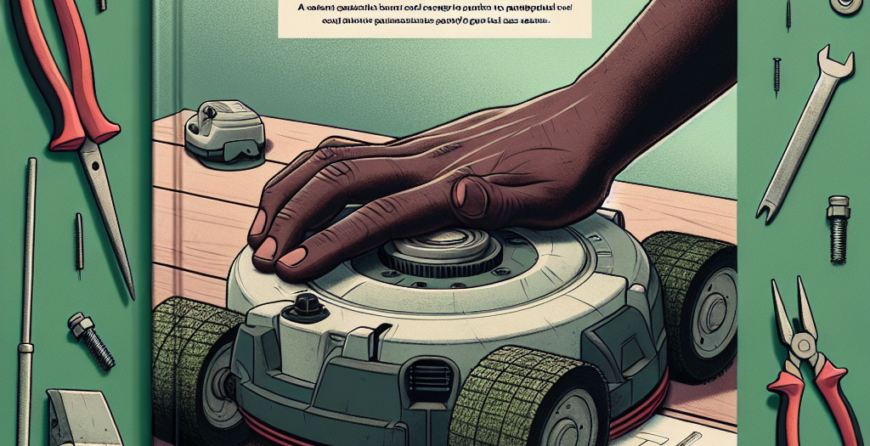If you’ve invested in a robotic lawn mower, you know the convenience and efficiency it brings to maintaining your yard. However, neglecting one crucial aspect can turn your verdant oasis into a patchy nightmare: failing to replace your mower blades regularly. This essential guide to replacing robotic lawn mower blades will equip you with the necessary knowledge to keep your mower performing at its best, ensuring a lush and healthy lawn. Discover how keeping those blades sharp can solve common lawn problems and enhance your robotic mower’s effectiveness.
Understanding the Importance of Replacing Mower Blades
Replacing the blades on your robotic lawn mower is not just a routine maintenance task; it’s a critical factor that directly influences the health and appearance of your lawn. Dull blades can lead to uneven cuts, tearing grass rather than slicing it cleanly, which can cause stress to the grass and lead to disease or pest infestations. This can result in a lawn that looks ragged and unkempt, defeating the purpose of having a robotic mower in the first place.
Moreover, using worn-out blades can strain your mower’s motor, potentially leading to malfunctions or requiring premature replacements of costly components. This added wear and tear can significantly reduce the lifespan of your equipment, making timely blade replacements an investment in the longevity of your mower. Not only does this save you money, but it also ensures that your mower operates efficiently, providing that pristine cut you desire.
Lastly, sharp blades contribute to a cleaner lawn by promoting healthier grass growth. Healthier grass is more resilient, retaining moisture better and resisting weeds. This means that regular blade maintenance isn’t merely about aesthetics; it can lead to a more robust and sustainable lawn ecosystem, making your outdoor space a true reflection of care and diligence.
Step-by-Step Process for Replacing Robotic Lawn Mower Blades
Preparation for Blade Replacement
Before diving into the mechanics of blade replacement, ensure you have all necessary tools and equipment ready. You will typically need a wrench or socket set, gloves for safety, and the new replacement blades compatible with your specific model. Consult your mower’s manual for precise specifications. Knowing the correct torque specifications for blade installation is crucial; under-tightening might cause them to come loose during operation, while over-tightening can damage the motor.
Next, it’s important to prepare your working area. Choose a flat, stable surface to prevent accidents while changing the blades. Turn off the mower and remove the battery for safety. This step is often overlooked, but it’s essential to prevent any accidental activation of the mower while you work.
Removing the Old Blades
Once your work area is prepared, you can start the blade removal process. Use the appropriate tools to unscrew the blades. Depending on the model, blades may be held in place with bolts or clips. It’s advisable to take a photo of the blade arrangement or refer to your manual for guidance in reassembly. After loosening the fasteners, carefully remove the blades and set them aside. Be cautious, as blades can be sharp and may pose a cut risk.
Inspect the mounting area for any debris or grass buildup, which can affect the new blades’ performance. Cleaning this area can enhance the efficiency of your mower. It is also a good opportunity to check for any signs of wear on the mower itself, such as the motor or the battery compartment, thereby allowing for proactive measures to be taken.
Installing the New Blades
With the old blades removed and the area cleaned, it’s time to install the new blades. Align them carefully with the mounting holes, ensuring they fit snugly. Use the manual to confirm that you are positioning them correctly. Once aligned, securely fasten them in place, adhering strictly to the torque specifications outlined in your mower’s manual. Over-tightening can cause damage, so this step requires a careful approach.
After the blades are securely installed, double-check your work. Ensure all fasteners are tight and that there is no play in the blades. Reattach the battery to the mower and perform a functional check in a controlled environment, observing the mower as it operates for the first time with the new blades. This will not only confirm that the installation was successful but also allow you to assess the quality of the cut and make further adjustments if necessary.
Conclusion and Encouragement for Regular Maintenance
Regularly replacing your robotic lawn mower blades is a game-changer for maintaining a lush, healthy lawn. By committing to this simple maintenance routine, you can avoid common pitfalls associated with neglected blades, enhance your mower’s performance, and ultimately create a thriving outdoor environment. The steps outlined in this guide are straightforward, ensuring you can carry out the task with confidence and minimal fuss.
Remember, a well-kept lawn is not just about aesthetics; it’s about fostering a healthy ecosystem right in your backyard. As you integrate this practice into your seasonal maintenance routine, consider documenting the condition of your blades regularly. This practice can help you anticipate when replacements are necessary and ensure your robotic mower continues to produce that perfect cut.
Now that you possess the knowledge of blade replacement, take action today. Regular maintenance will not only save you money in the long run but also provide the satisfaction of knowing you are doing your part to nurture your lawn. Dive into the world of lawn care with renewed vigor, and make blade replacement an integral part of your home maintenance strategy!
By investing time in understanding and executing the replacement of your robotic lawn mower blades, you’re not just enhancing your machine’s performance—you’re investing in the beauty and health of your lawn. Embrace this essential maintenance task and watch your outdoor space flourish!
Maximizing Efficiency: Robotic Lawn Mowers for Small YardsExploring Boundary-Free Robotic Lawn Mowers: A New EraEnhancing Lawn Care: The Benefits of GPS-Enabled Robotic MowersRelevant LinkRelevant LinkRelevant Link



